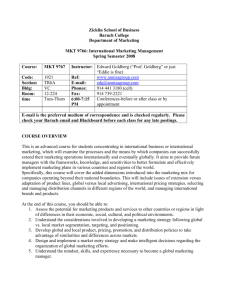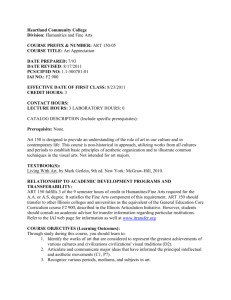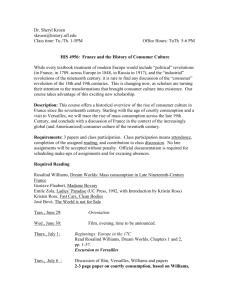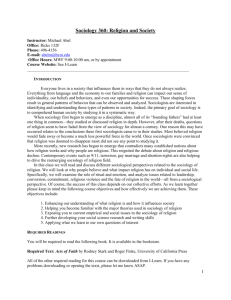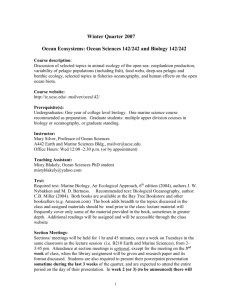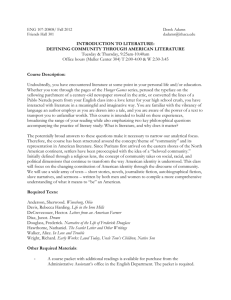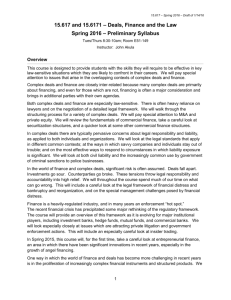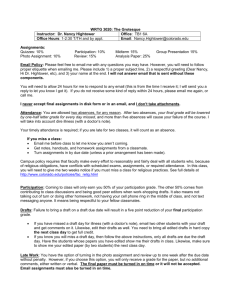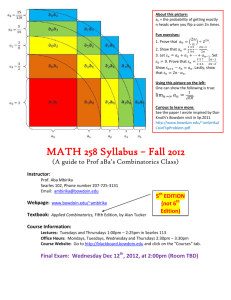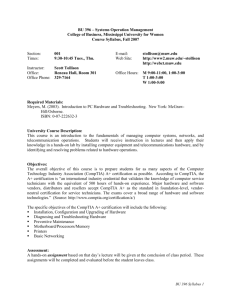View Syllabus
advertisement
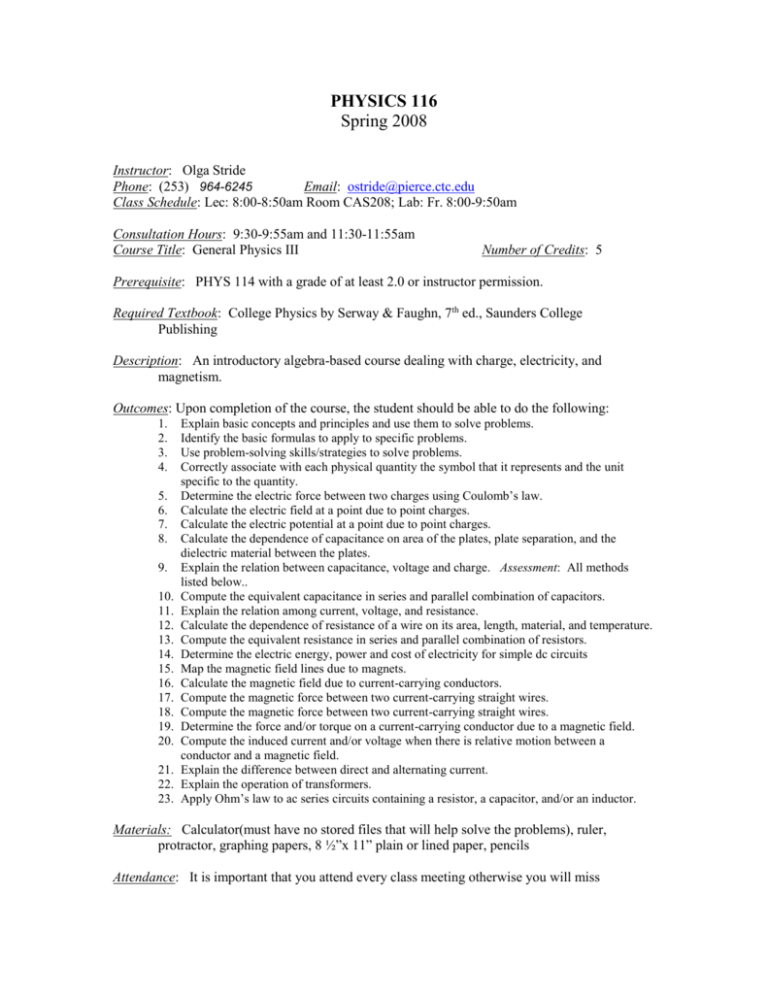
PHYSICS 116 Spring 2008 Instructor: Olga Stride Phone: (253) 964-6245 Email: ostride@pierce.ctc.edu Class Schedule: Lec: 8:00-8:50am Room CAS208; Lab: Fr. 8:00-9:50am Consultation Hours: 9:30-9:55am and 11:30-11:55am Course Title: General Physics III Number of Credits: 5 Prerequisite: PHYS 114 with a grade of at least 2.0 or instructor permission. Required Textbook: College Physics by Serway & Faughn, 7th ed., Saunders College Publishing Description: An introductory algebra-based course dealing with charge, electricity, and magnetism. Outcomes: Upon completion of the course, the student should be able to do the following: 1. 2. 3. 4. 5. 6. 7. 8. 9. 10. 11. 12. 13. 14. 15. 16. 17. 18. 19. 20. 21. 22. 23. Explain basic concepts and principles and use them to solve problems. Identify the basic formulas to apply to specific problems. Use problem-solving skills/strategies to solve problems. Correctly associate with each physical quantity the symbol that it represents and the unit specific to the quantity. Determine the electric force between two charges using Coulomb’s law. Calculate the electric field at a point due to point charges. Calculate the electric potential at a point due to point charges. Calculate the dependence of capacitance on area of the plates, plate separation, and the dielectric material between the plates. Explain the relation between capacitance, voltage and charge. Assessment: All methods listed below.. Compute the equivalent capacitance in series and parallel combination of capacitors. Explain the relation among current, voltage, and resistance. Calculate the dependence of resistance of a wire on its area, length, material, and temperature. Compute the equivalent resistance in series and parallel combination of resistors. Determine the electric energy, power and cost of electricity for simple dc circuits Map the magnetic field lines due to magnets. Calculate the magnetic field due to current-carrying conductors. Compute the magnetic force between two current-carrying straight wires. Compute the magnetic force between two current-carrying straight wires. Determine the force and/or torque on a current-carrying conductor due to a magnetic field. Compute the induced current and/or voltage when there is relative motion between a conductor and a magnetic field. Explain the difference between direct and alternating current. Explain the operation of transformers. Apply Ohm’s law to ac series circuits containing a resistor, a capacitor, and/or an inductor. Materials: Calculator(must have no stored files that will help solve the problems), ruler, protractor, graphing papers, 8 ½”x 11” plain or lined paper, pencils Attendance: It is important that you attend every class meeting otherwise you will miss in-class activities such as seatwork, discussion, class experiments, demonstrations, video films, etc. These daily activities cannot be made up. Assessment: Your grade for the course will be based on laboratory work (20%), homework(15%), in-class activities (5%) and tests (60%). Lab and lecture times may be interchanged as necessary. Selected lab experiments will require formal reports. A formal report must include title, purpose, theory, list of apparatus, diagram, procedure, data, results, analysis of results, conclusion and answers to questions. Lab reports must be handed in at the beginning of the class on the due date. Submission after this time is considered late and will be given 10% deduction on the first day and another 10% per day that the report is late. A missed lab must be made up on or before the next lab day. Exercises will be assigned for each section covered. When solving problems, complete steps must be shown neatly and orderly including units and diagrams where needed. Homework must be handed in at the beginning of the class on the due date. Late homework will be given 25% deduction each day it will be late and it will not be accepted after the corresponding chapter test. There will be seven (7) tests. All tests must be taken so if you anticipate an absence, make prior arrangement with the instructor. If you missed a test, make it up before the test result is shown to the class. Your lowest test will be dropped. Solutions to test questions should include complete steps, diagrams, and appropriate units, otherwise, full credit will not be given. Grading scale: % 100 99 98 97 96 95 94 93 92 91 90 89 88 87 86 Decimal 4.0 4.0 3.9 3.9 3.8 3.8 3.7 3.6 3.6 3.5 3.5 3.4 3.3 3.2 3.1 Grade A A A A AAAAAAAB+ B+ B+ B % 85 84 83 82 81 80 79 78 77 76 75 74 73 72 71 Decimal 3.0 2.9 2.8 2.7 2.6 2.5 2.4 2.4 2.3 2.3 2.2 2.2 2.1 2.1 2.0 Grade B B BBBBC+ C+ C+ C+ C+ C+ C C C % 70 69 68 67 66 65 64 63 62 61 60 59 58 57 <56 Decimal 2.0 1.9 1.8 1.7 1.6 1.5 1.4 1.3 1.2 1.1 1.0 0.9 0.8 0.7 0.0 Grade C CCCCCD+ D+ D+ D+ D D DDF Late Withdrawals, “W”, can be given up to a date specified by the college. It is your responsibility to fill up the withdrawal form, ask the instructor’s signature, and submit this to the registrar’s office for processing. Academic Dishonesty: Any student caught cheating on any test will received a 0.0 grade. Please refer to the college catalog (page 20) for more information. Working Together: It is advisable for students to work together to discuss examples and homework problems. A group of two to three students is good. However, I urge each one to complete the final work alone to have a better grasp of the solutions. Tutoring: Sometimes, the tutoring center is lucky to have peer tutors who have background in physics. You may choose between drop-in or matched one-to-one with a tutor. Be sure to inquire for more information from the tutoring center. Special Needs: If you are a student who has a disability and needs special accommodations, please notify me and Disability Support Services Office. Classroom Conduct: I expect everyone to make the classroom environment conducive to learning. Devices such as cell phones, music players, laptops, pagers, and others must be turned off. Physics Lab Report Procedures Purposes of lab: To supply the practical knowledge necessary for a better understanding of physics To develop familiarity with the experimental method of scientific investigation To give the student experience in the actual handling of laboratory apparatus Lab report grades will be based on the following: a) Properly following all procedures These procedures refer to taking measurements and writing the lab report. b) Proper use of units and significant figures Be sure to include units with all measurements. If you are listing values in a table form, label the rows and/or columns rather than individually. Round off when necessary, but do not round off values prior to using them in calculations as this can introduce “round off errors”. The most important value to be rounded off is the final result in your conclusion. Make sure you use the rules for significant figures. c) Plausibility of final result Your result does not necessarily have to agree with everyone else’s nor does it have to be equal to the expected result. However, make sure that it makes sense. d) Organization and neatness Make sure that any reader can quickly read and understand all aspects of your report. To avoid messy erasures, you may use a computer to write your report. e) Error analysis You must always be aware of all possible errors. Some errors can be avoided but others cannot be eliminated. In some experiments, you may be asked to find the percent error only. In others, you may be asked to do a detailed error analysis. This will be discussed in more detail later. Report Format: Follow this outline for all formal lab reports. LAB TITLE Name Date Group mates I. Purpose - This is a brief statement on what the experiment is intending to show and/or what you are supposed to find out. II. Theory - This contains the theories, principles, laws, definitions, and/or equations including derivations of equations used in the final results. Be sure you include necessary diagrams. Also, identify all symbols that you will be using in the report. III. Apparatus - List all apparatus used in the experiment here. IV. Procedure - Number and list each step of the experimental procedure. Be as brief as possible. Provide simple and labeled diagrams showing where each measurement was taken. V. Data - If possible, place all data in table form with labels. You should take several measurements where necessary to reduce random errors. All data should be included, even those that seem unbelievable. VI. Graphs - These should be part of the report when required. Make each as large as possible using a full sheet of engineering paper and clearly labeled with a title and units for the measured quantities. Show all data points clearly on the graph. VII. Calculations - All calculations, including error calculations when required, belong here. When doing multiple calculations using the same equation, you may show one sample. The answers to your calculations for the result(s) should be in tables, rows, or columns for easy reading. Be sure to explain each calculation and symbol used. VIII. Conclusion - This is the summary and discussion of the final results. It usually involves a comparison of the computed results with the accepted values together with the percent errors involved. You must add a brief discussion of the sources of these errors and any other comments you would like to make about the working of the experiment. IX. Answers to Questions - Some experiments may include questions or problems. Take care to use complete sentences and make the answers as clear and readable as possible. PHYSICS 116 Tentative Schedule Spring 2008 Day Day Date Lecture Homework Lab 1 Tues April 1 Ch 15 2 Thurs 3 3 Tues 8 4 Thurs 10 Field Mapping 5 Tues 15 Capacitors 6 Thurs 17 7 Tues 22 8 Thurs 24 9 Tues 29 10 Thurs 11 Tues 6 12 Thurs 8 13 Tues 13 14 Thurs 15 Fri 16 15 Tues 20 16 Thurs 22 17 Tues 27 18 Thurs 29 19 Tues 20 Thurs 5 21 Tues 10 Thurs 12 Electrostatics Ch 16 Ch 15 Ch 17 Ohm’s Law Ch 18 Ch 16 DC Circuits May 1 Ch. 17 Magnetism Ch 19 Fieled Mapping Ch 18 Last Day To Withdraw Ch 20 Induction Ch. 19 AC Circuit Ch. 21 June 3 Break: June 14-22 Test Ch. 20 Transformer Final Test Summer Quarter begins Monday, June 23 Ch 21


